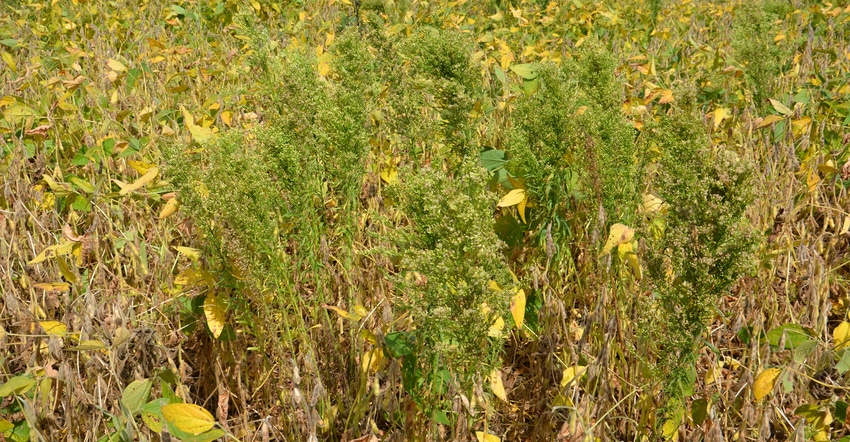
One farmer commented this fall that he was sick and tired of finding marestail in his soybeans before harvest. As he put it, they seem to "laugh at glyphosate." He wonders if they’re resistant to it, or if he is doing something wrong in his approach to control them. Agronomists assure him that he isn’t alone. Marestail plagues hundreds of Indiana farmers.
“Glyphosate-resistant marestail is common throughout Indiana,” says Rick Nagel, an agronomist with Ceres Solutions, Lafayette. “From a management standpoint, assume glyphosate is no longer very effective on marestail populations.”
Several years ago, a spring burndown of glyphosate plus 2,4-D typically worked well on marestail, Nagel notes. “Now most of the control comes from the 2,4-D, and we’re finding that the once-dependable tankmix is very inconsistent on marestail that overwintered when it’s spring-applied.”
One thing that makes marestail tough to control is its ability to germinate in the fall and overwinter in the rosette stage. If it grows out of that stage in the spring before a herbicide application, it’s tougher to stop.
Nagel notes, however, that the combination of glyphosate and 2,4-D still works well if applied in the fall or on marestail plants that emerge in the spring.
Planned program
Here are five components to a well-rounded marestail control program. Darrell Shemwell, manager of the Poseyville branch of the Posey County Co-op, also contributed to this plan. Both Nagel and Shemwell are Indiana Certified Crop Advisers.
1. Consider either aggressive tillage or a fall herbicide application. “Without a fall application , overwintering marestail plants are very difficult to control with spring burndown applications,” Nagel says. He recommends 2,4-D, dicamba and/or glyphosate in fall applications. A fall application will control small marestail plants.
2. Use a spring burndown or effective tillage to control spring-emerged plants. Most popular vertical-tillage tools are not effective to take out marestail, Nagel observes. This is especially true if no fall herbicide was applied. “Even if you can’t see marestail plants from the pickup on a drive-by, assume that they are in the field,” Nagel emphasizes.
3. Use a spring burndown that is effective against germinating marestail plants. Several premix options are good, Nagel says. He believes herbicide mixes that contain Authority or Valor plus metribuzin are most effective.
4. Plant Roundup Ready 2 Xtend or LibertyLink soybeans in problem fields. “We have no consistently effective, post herbicides for Roundup Ready 2 soybeans,” Nagel says. Liberty applied over LibertyLink soybeans and dicamba in Xtend over Xtend soybeans should be effective, but both should be applied on weeds smaller than 4 inches for effective control, he says.
5. Take a hard look at what XtendiMax could offer against marestail. “You can spray XtendiMax over Xtend-tolerant soybeans as a burndown with no waiting to plant,” Shemwell says. “You can also make an in-crop application of XtendiMax to control marestail.”
Reading and understanding the label for XtendiMax is crucial, Shemwell notes. Currently, there are several restrictions on how, when and where you can spray it, especially as a postemergence application. “I feel XtendiMax will do an excellent job of controlling the marestail,” he concludes.
About the Author(s)
You May Also Like




